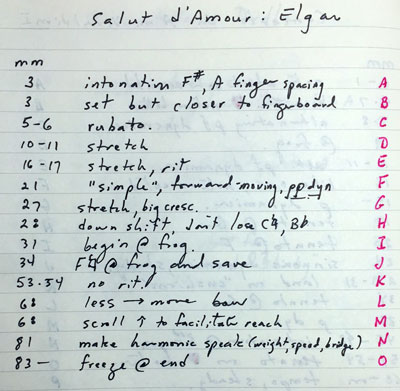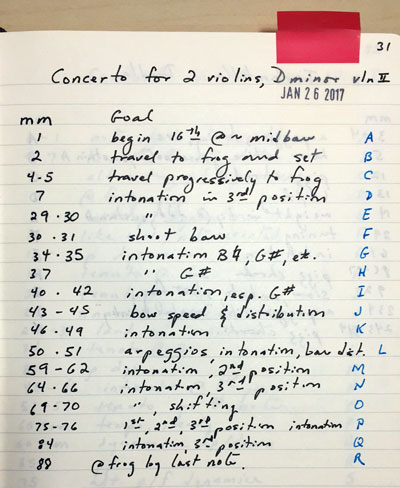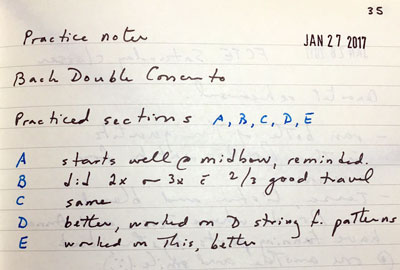Some day, I’ll figure out the best method for taking notes in lessons. But until then, here’s my current approach.

I’m on a personal odyssey to find better ways to take practice notes.^[Although I’ve usually called them lesson notes, perhaps a better term is practice notes. Why? Because they’re not really backward-looking to the lesson, they’re forward-looking to the week’s practice. So, practice notes.] For about a year, I took notes solely on an iPad, as I wrote about previously. Although I enjoyed the process of annotating the scores directly on the iPad, preparing the scores each week for use on the tablet took a lot of time. As my daughter became busier, it was impossible to keep up. So I’ve returned to pen and paper note-taking.
As I’ve begun handwriting notes again, I’ve noticed a glaring deficiency in how we take notes for use in practice. It goes like this. Each week, we go to lessons and dutifully take notes about the working pieces, exercises and other assignments. We go home and practice those. The next week, we do the same thing. So the notebook becomes a chronological record of lessons week-to-week. But what happens when your goal is help your child polish a piece for a recital, festival performance, or audition? Then, to make sure all of the points are covered in your home preparations, you have to reconstruct the record of practice points by going backward through your notes. If your note-taking is as cryptic as mine, this can be a daunting task. You could use the score as a record of all of the practice recommendations, but after weeks of working on a piece the score ends up with a dense patina of marks that are more cryptic than the original notes.

Each piece gets a separate index page with measure-by-measure practice points
Now I use a new method. During lessons I still take notes as usual, but I set aside separate pages in my notebook for each piece that my daughter is polishing for performance. On each page, I make a table with measure numbers in the left hand column and a description of the practice point in the middle column. The right-most column gives each point a letter that I use for shorthand notation during the week. Then I bookmark these index pages with a self-adhesive flag so I can refer to them readily.

Righthand column is shorthand notation for daily notes
As we find new trouble spots or the teacher points out new areas to work on, I add them to the list. Finally, after practice each day, I jot down the points that we worked on during that session. This is of enormous help the next day when we practice because I can quickly plan what to work on next or whether we need to continue working on some of the same points from the previous day.

Daily practice notes refer to index page for that piece
Having per-piece index pages in my notebook has become an enormous time saver and source of confidence that our preparations are on-track and comprehensive.
What note-taking ideas have you found work for you? Comment at the Suzuki Experience Facebook page.





